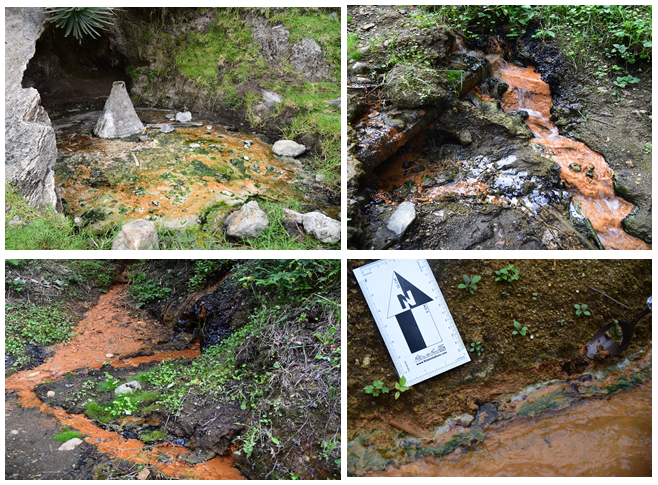Evaluating the potential of the hydrothermal sites from the Doña Juana Volcanic Complex as Planetary analogues
- 1University of Tübingen
- 2LATMOS, Laboratoire Atmosphères, Observations Spatiales, Guyancourt, France
- 3RG Energy
- 4Escuela de Ciencias aplicadas e Ingeniería, Universidad Eafit, Medellin, Colombia
1. Introduction
The search for traces of life and biomarkers is one of the main goals of the space exploration towards Mars and the ocean worlds. In this quest, terrestrial
analogues are being used in support of space exploration due to their similarities with the environmental conditions and mineralogies of the planetary bodies targeted by space missions. Specifically, terrestrial analogues serve to guide, prepare, and optimize the flight instruments and the analytical protocols as well as help interpret the in situ data obtained by flight instruments. On Earth, many environments have been identified as targets for planetary sciences and astrobiology because of their extant life and diverse microbial diversity, but also for their capability to preserve biomarkers. Mineral deposits from geothermal hot spring environments constitute one of these interesting targets due to the preservation of textural and organic biomarkers (e.g., lipids) [1, 2, 3]. One of these potential environments is located in the vicinity of the Doña Juana Volcanic Complex (DJVC) in Southwest Colombia. This region hosts numerous hot springs with diverse fluid compositions, geothermal pool temperatures, pHs, and a variety of mineral deposits. These deposits are potential strong repositories of biomarkers, yet only so little is known about their mineralogy, geobiochemistry, or their potential for organic biomarkers preservation.
2. Objective
This study aims to explore the geothermal hot springs near the DJVC to perform a comprehensive biogeochemical study of the hot spring mineral deposits and waters of the geothermal sites of the DJVC in order to enhance our understanding of their mineralogy, geobiochemistry, and their capability to preserve biomarkers and evaluate their potential as planetary analogues. To do so, liquid and solid samples were collected in the geothermal systems of Las Animas and Tajumbina [4].
3. Sample sites and preliminary analyses
The hydrogeochemical analyses that have been performed on the hot springs of the DJVC have allowed to highlight the variety of geothermal pools
present with temperatures ranging from 24 to 69 °C, pH values between 5.75 and 6.7, and an estimation of deep geothermal reservoir temperature over 180 °C [4]. The thermal waters at DJVC also present a variability of water chemistry, and have been divided into two groups: the calcium sulphate-bicarbonate
waters of the Doña Juana System (DJS) and the sodium-chloride waters of the Animas System (AS) [4]. Because of the complex mineral assemblages
within the geothermal pools of DJVC, the DJVC deposits represent a great potential terrestrial analog of the martian deposits that are currently being
explored and collected by the Perseverance rover. The future Rosalind Franklin rover of the Exomars 2028 mission is also aiming to expand the sampling
on Mars, making the study of DJVC deposits more relevant.
4. Laboratory experiments
The samples collected are being characterized using multiple analytical techniques, including techniques that are relevant for the current and future exploration of Mars. The textures, mineralogy, and organic chemistry of the potential Mars analogue features will be characterized using Scanning
Electron Microscopy (SEM), Raman spectroscopy, and X-Ray Diffraction analysis, FTIR. Elemental analysis-isotope ratios mass spectrometry (EA-IRMS)
will also be performed in order to determine the Total Organic Content (TOC) of the samples. Further organic geochemistry experiments will include solid-
liquid extractions as well as flight-like experiments including pyrolysis-GC/MS and wet chemistry techniques relevant for current and future flight-
missions. These experiments will allow to evaluate the biosignatures from the microorganisms thriving in the pools and colonizing the mineral deposits and
to evaluate their preservation potential for biosignatures from extinct forms of life.

Figure 1. Context photos of the sampling sites. Top left: Las Animas, Top right and bottom: Termales de Tajumbina.
Acknowledgements
Support for this research was provided by the ANR LIBIOPANE project, grant ANR-23-CE49-0001 of the French National Research Agency, ANR (Agence
Nationale de la Recherche). The authors acknowledge the municiplity of La Cruz, Nariño, the staff of Termales de Tajumbina and we also thank the
rangers of Parque Nacional Natural Complejo Volcánico Doña Juana- Cascabel for their guidance in the field and their support in the collection of the
samples.
References
[1] McMahon et al. (2018), JGR Planets, 123
[2] William A. (2019) Astrobio. 19, 1-26.
[3] Teece et al., (2023) Astrobio. vol. 23, 2, p. 155-171.
[4] Diaz, E. & Marín-Cerón, M.I. (2020), Geothermics, 4, 101738.
How to cite: Tenelanda-Osorio, L., Millan, M., Aguilera, P., and Marín-Cerón, M. I.: Evaluating the potential of the hydrothermal sites from the Doña Juana Volcanic Complex as Planetary analogues, Europlanet Science Congress 2024, Berlin, Germany, 8–13 Sep 2024, EPSC2024-1303, https://doi.org/10.5194/epsc2024-1303, 2024.